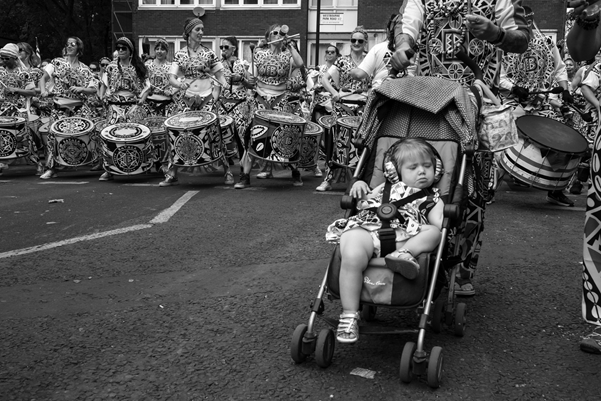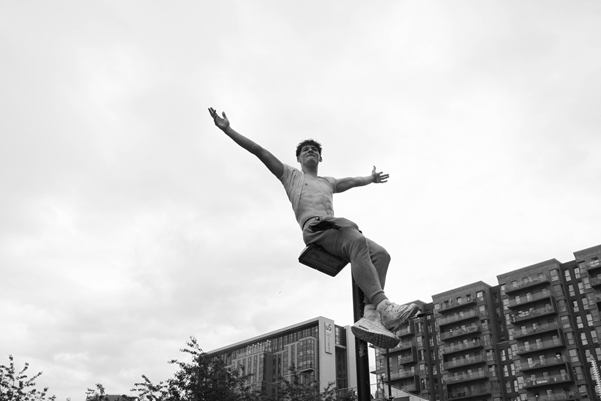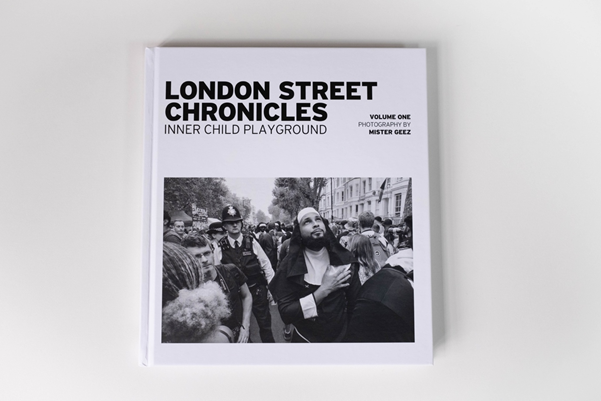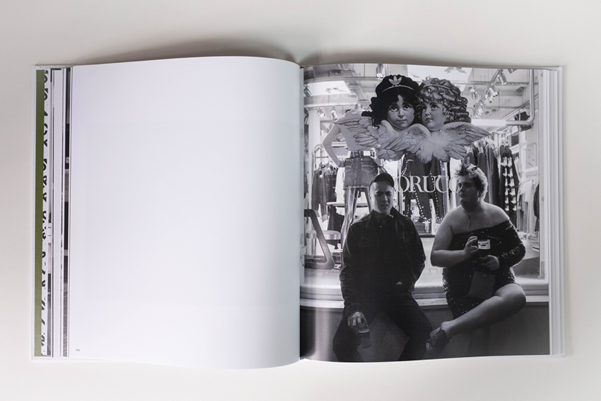I recently spotted visual artist Gerald Marie-Nelly, also known as Mister Geez at ‘The Other Art Fair’ in Shoreditch and I fell in love with his un-posed and eye-catching documentary photography. As a fan of risqué street style and artistic photography, I was automatically taken by his black and white compositions and the authenticity and personality that shines effortlessly through his work. When I looked at his photographs more closely, I began to recognise exactly where in London they were captured (like my boyfriend’s actual street in Notting Hill) and this connected me even more to them. They’ve picked me up at a time when life was dragging me down, proving how enriching and uplifting art can be.
Originally from the French island of Martinique, but very much settled in London now, Mister Geez is a visual artist inspired by his Caribbean roots and city life. His photography, seen in projects like his “Inner Child Playground” from his London Street Chronicles series, captures human interactions in documentary or street photography contexts.
I had the pleasure of talking to Mister Geez about his love of multicultural London and photography, his life-changing voluntary work at Crisis Charity, his approach to visual storytelling and much more..
It was fabulous seeing your work for the first time at The Other Art Fair this month. Your photos are so striking and compelling and stood out to me the most at the art fair. How did your artistic journey into street photography begin?
First of all, thank you for interviewing me and for your kind words about my work—I truly appreciate it.
Looking back, I think I always had an artistic seed in me. As a child, the only subjects I truly enjoyed in school were sports and art. During my teenage years, I became fascinated by video games, which led me to study computer science at university and pursue a career in the web industry. But creativity was always present in some form—whether designing leaflets for events or later running a Caribbean music podcast.
In 2011, a deeply personal event sparked my passion for photography. My mother passed away suddenly, and due to the circumstances, her body had to undergo two autopsies. As a result, we couldn’t hold the traditional open-casket wake when we finally received her body two weeks later.
My father sent me to my mother’s house to find a photo of her that we could print and place on the coffin for people to pay their respects. I thought it would take 15 minutes—but it took six hours. I sifted through albums, boxes full of photographs, crying, laughing, and realizing how few images truly captured her essence. Then, I found a black-and-white portrait taken when she was in France studying to be a nurse. It was perfect—timeless, ageless, and unmistakably her.
At that moment, something clicked, like a bolt of lightning. I understood the profound importance of capturing special moments and the power of a printed photograph. It wasn’t just an image—it was a key unlocking a safe filled with emotions and priceless memories.
Three years later, when my daughter was born, I picked up a camera for the first time—and I haven’t put it down since. In many ways, my journey into photography began in a dark place which led me to seek light through my lens.
What are your thoughts on London’s influential and world leading risqué and unique street style and how do you compare it with other cities you’ve photographed?
London’s fashion scene can definitely be bold and edgy, particularly in areas like Brick Lane, Portobello, Soho, Carnaby Street, or Camden. On the other hand, it can also be elegant and sophisticated in places like Mayfair or Hampstead. These areas are great for street photography because they attract interesting characters with unique outfits.
That said, fashion isn’t the main factor I consider when choosing a location to shoot. While I know where I might find hipsters or gentlemen with distinctive styles, I don’t seek out subjects based on their outfits. For me, the scene and the action matter more than what people are wearing—though fashion can certainly enhance a composition or add an unexpected layer to an image. My process is instinctive; if something piques my interest, I go for it. Fashion might be what initially catches my eye, but it’s never the priority.
Compared to other cities where I’ve done street photography—such as Paris, Brussels, or Stockholm—I’d say their fashion style tends to be more understated or refined in a distinctly continental way. It’s a different aesthetic, but since fashion isn’t my primary focus, it doesn’t influence my approach. You could drop me in a place where everyone wears the same uniform, and I’d still do my best to find something compelling to capture.

‘Sun Tan at Sundial’
Notting Hill Carnival is such a vibrant celebration of London’s multiculturalism. In your view, how well does the two-day Carnival showcase post-war integration, and what other aspects of London life do you think contribute to this story?
Notting Hill Carnival is the biggest street festival in Europe, which is no small feat! I take great pride in the fact that it is deeply rooted in Caribbean culture, showcasing the strong sense of togetherness among Afro-descendant communities and their joy in celebrating life while embracing others. It’s a beautiful event that often gets an unfair reputation in the media, despite statistics showing it to be one of the safest large-scale events—especially considering the more than two million people who attend each year with very few incidents.
Stepping back to its deeper origins, Carnival in the Caribbean has always been an act of emancipation—rising above the atrocities of slavery and reclaiming joy and identity. In London, it was born from a similar spirit, serving as a positive response to the racial tensions faced by the Windrush generation and a celebration of immigrant diversity.
That said, Notting Hill Carnival is a testament to Britain’s progressive approach to integration. In many ways, my own presence in London instead of France speaks to this. London allows people to be themselves while respecting British values, whereas in some places, the concept of assimilation demands that immigrants erase parts of their identity to be accepted—which is deeply flawed.
Ultimately, Notting Hill Carnival might be the purest expression of London’s multiculturalism. And from a photographer’s perspective, it never, ever disappoints!

‘Nap Time’
What’s your process and technique for capturing these spontaneous moments of urban life in your photos?
It’s hard to pinpoint exactly how I manage to capture those special moments—because, ultimately, the key is simply being in the right place at the right time. And the only way to achieve that is by spending time out there, fully immersed in the environment.
Street photography isn’t for the faint-hearted. It requires a love of exploration—both of physical spaces and human connections. The camera and the photographs themselves are just the cherries on top, tangible artefacts that serve as precious reminders of what the street had to offer on any given day.
My Caribbean upbringing also plays a role in my love for walking and observing the world. As a child, I was always drawn to exploring—sometimes even getting into trouble for wandering instead of going straight to school! That curiosity and instinct for discovery have never left me.
My process is built on discipline and consistency, something I honed while volunteering as an assistant photography teacher at the Crisis charity from 2018 to 2020. Jeff Hubbard, the teacher who became my mentor, instilled in me the power of routine: shoot, edit, print, repeat. That cycle is what strengthens both the craft and the vision.
As for technique, it’s a combination of relentless practice and deep visual study. To sharpen the eye, I recommend consuming as many photography books as possible. For self-taught photographers, understanding concepts like harmony, balance, and composition is crucial—because ultimately, great street photography isn’t just about capturing a scene, but about presenting it in a way that resonates with the human eye.
You clearly have a talent for pushing the boundaries of visual storytelling. How did your special talent for this originate and continue to evolve?
Thank you for the compliment—haha!
Beyond the discipline and consistency required for photography, I believe a photographer’s personality naturally surfaces in the frames they capture. If I enjoy a good laugh and admire athleticism, for example, I might be drawn to capturing humorous moments or dynamic, expressive movements in the street.
In that sense, my approach to visual storytelling is deeply rooted in how I see the world. We live in a time filled with distractions and divisive narratives, especially in the media, where the dominant discourse often paints a grim picture of society. But when I’m in the street, I strip all of that away. I keep it simple. I treat everyone the same.
My photography is fuelled by empathy, humanism, and, whenever possible, positivity. It’s my way of capturing the world as it is—not as bad as certain agendas would have us believe. The moment you step outside and engage with strangers, what stands out first is our shared humanity. The distractions of ideology and politics don’t have time to interfere. And that’s where truly interesting visual storytelling begins.

‘It was coming home’
What inspired the first volume of ‘Inner Child Playground’ of your ongoing project London Street Chronicles and how has the project been going so far?
After six years of street photography, I realised I had amassed an enormous body of work and felt it was time to do something with it. The first step was a virtual exhibition during the Covid lockdown in 2020, which received great feedback. That encouraged me to explore the idea of a book—but after six unsuccessful attempts at putting it together on my own, I felt the result wasn’t strong enough. So, in 2022, I went back to the streets, shooting consistently every week to refine my vision.
In 2023, I revisited the book idea, this time working with a designer and an editor—which made a huge difference. My mentor, Jeff Hubbard, suggested breaking it into multiple volumes rather than trying to fit too many themes or styles into a single book. That advice reshaped my approach.
One recurring pattern in my work stood out to me: playful scenes, strong juxtapositions, and contrasts—opposites interacting in unexpected ways. I realised I had been using the city as a playground, instinctively channelling the sense of adventure I had as a child growing up in the Caribbean. That insight became the foundation for Inner Child Playground, the first volume of London Street Chronicles.
The project has been well received so far. The first print run of 130 copies sold out in about three months.
I’ve been busy with commissions, building a darkroom and working on Volume 2 throughout 2024, but since it’s not quite ready yet, I decided to do a reprint of 500 copies of Volume 1. This way, it remains available online and at events until the next volume is released later this year.

What are your ambitions moving forwards and where do you see yourself going as a visual artist living and working in London?
Moving forward, I plan to continue expanding the London Street Chronicles series—I already have concrete ideas for multiple future volumes.
Beyond that, I’m focused on refining my printmaking techniques. Since 2021, I’ve been learning the platinum/palladium alternative process with the Master printer Roberto Aguilar in Durham to create rich, handmade black-and-white prints. I also enjoy exploring mixed media projects that blend photography and data visualisation, particularly through cyanotype blueprints. These experiments allow me to push my artistic practice beyond traditional photography.
Right now, my energy is fully dedicated to becoming a full-time artist. I’m still freelancing in the IT industry to support my family and self-fund my work, but the goal is to transition entirely into my art.
Living in London offers incredible opportunities—not just for exposure within the city but also as a launching pad to showcase my work across other European cities. I’m excited to see where this journey takes me.

‘Soho Angels’
Mister Geez’s journey into photography began with a deeply personal moment that made him appreciate the power of capturing fleeting memories. Over the years, street photography has become his way of exploring the world with curiosity, humour, and empathy, documenting life as it unfolds in all its complexity. London Street Chronicles is an ongoing project that reflects this vision, capturing the energy and diversity of the city.
Beyond photography, he is also passionate about printmaking, working with platinum/palladium and cyanotype techniques to bring his images to life in unique, handmade forms. His goal is to transition into being a full-time artist while continuing to push the boundaries of visual storytelling. London has given him incredible opportunities, and he looks forward to expanding his work across Europe and beyond.
We will certainly be following what Mister Geez does from this moment on.
Interview by Julia Nelson
About: The Artist
https://www.saatchiart.com/en-gb/mistergeez
London Street Chronicles – Geez Visual Studio
Read Abundant Art’s latest feature Feature: Ceramics and its political agenda – Abundant Art